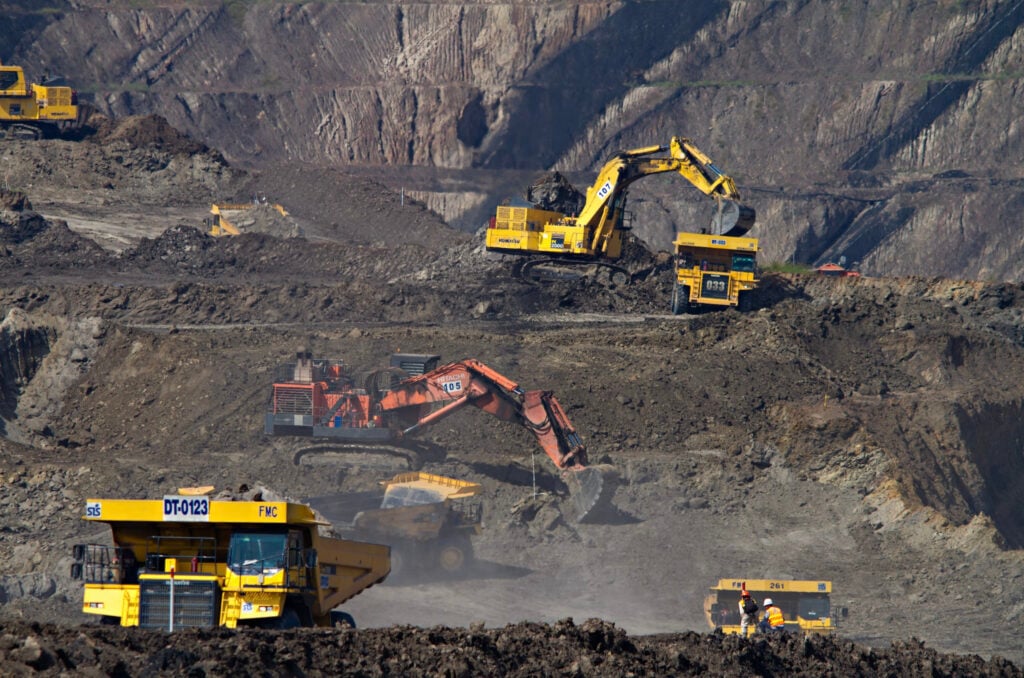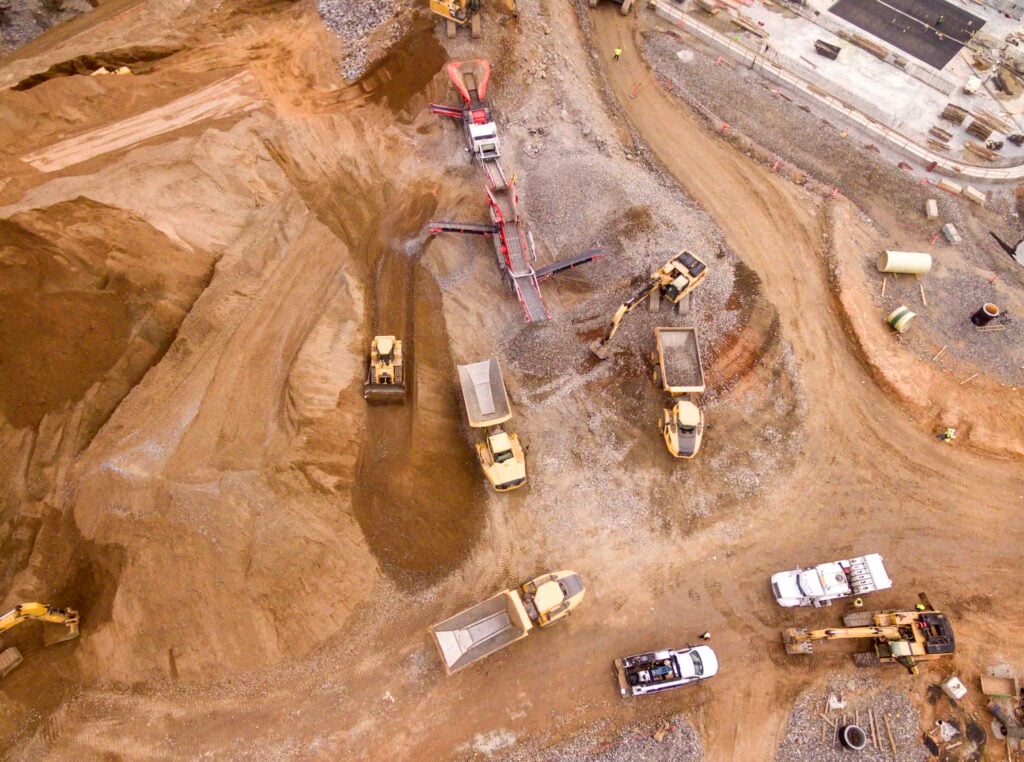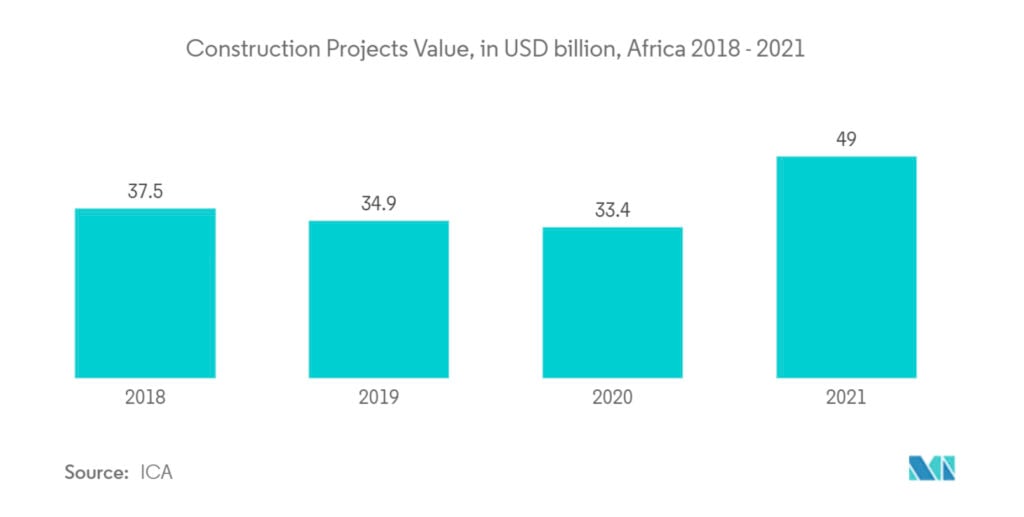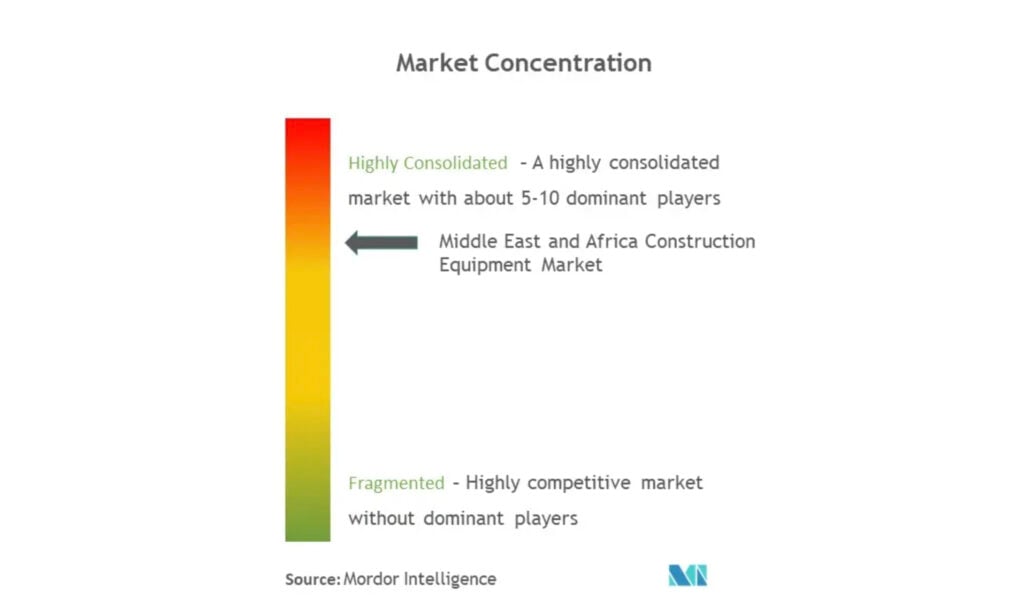The Middle East and Africa Construction Equipment Market is Segmented by Machine Type (Cranes, Telescopic Handler, Excavators, Loaders, Motor Grader, and Other Equipment), Drive Type (Electric and Hybrid and Hydraulic), and Country (Saudi Arabia, South Africa, United Arab Emirates, Qatar, Morocco, and Rest of Middle East and Africa). The report offers market size and forecasts for Middle-East and Africa Construction Equipment in value (USD Billion) for all the above segments.

MEA Construction Equipment Market Analysis
Currently, the Middle East and Africa Construction Equipment Market is valued at USD 4.26 billion. It is expected to reach USD 6.4 billion, registering a CAGR of 4% over the next five years.
The COVID-19 pandemic severely affected the construction industry and associated equipment demand across the Middle East and Africa. It was primarily attributed to disruptions in the supply chain, reduced investment in new equipment procurement, halt and postponement of construction projects, and unstable economic growth of many countries. However, since last year, the construction industry across the Middle East and Africa has been experiencing significant growth in investment and economic development, witnessing major orders for construction equipment from GCC countries in the region which is likely to drive the market in focus during the forecast period. For instance,
- In August last year, Doosan Infracore Co., a subsidiary of Hyundai Construction Equipment won an order to supply 62 units of construction equipment to major customers in Saudi Arabia and Bahrain.
Rising government investments in infrastructure development and major infrastructure projects in the Middle East and Africa, such as those in Saudi Arabia, Kuwait, Oman, the United Arab Emirates, and Egypt, are anticiapted to produce significant growth in the market. One of the major factors driving the growth of the market is the growing construction industry, especially in developing countries, owing to numerous growth opportunities in infrastructure, residential, and non-residential sectors. The rise in the construction of multi-family houses (with the growing trend of nuclear families), and increasing investments in the construction of roads, highways, smart cities, metros, bridges, and expressways due to the growing population and urbanization. The growing trend toward automation is expected to drive the growth of the market. For instance,
- This year, the United Arab Emirates announced plans to spend USD 23 billion on infrastructure developement.
However, factors, such as stringent emission regulations for construction machinery, are expected to hinder the growth of the market For instance,
Thus the confluence of all the aforementioned factors is projected to produce steady growth for construction equipment market in the Middle East and Africa over the next five years.
MEA Construction Equipment Industry Segmentation
Construction equipment is defined as any equipment used for the execution, completion, erection, operation, or maintenance of any construction project or work. Construction equipment is also used in earthmoving works during the construction of roads, bridges, and dams. Some construction equipment, like excavators and wheel loaders, are also used in mining.
The Middle East and African Construction Equipment Market is segmented by Machine Type, Drive Type, and Geography. The Middle East and Africa Construction Equipment Market are segmented by Machine Type into Cranes, Telescopic Handler, Excavator, Loaders, Motor Grader, and Other Equipment. Based on the Drive Type, the market is segmented into Electric, Hybrid, and Hydraulic. By Country, the market is observed in Saudi Arabia, South Africa, United Arab Emirates, Qatar, Morocco, and Rest of Middle East and Africa.
Rising Infrastructure Spending to Drive the Growth of Construction Mining Equipment in Middle East and Africa
Each country in the Middle East region has grown in the construction sector in its unique way over the years, adhering to its own pace, norms, and ambitions. The United Arab Emirates is responsible for significant projects, owing to Dubai’s more robust development and investment than the rest of the Middle East. High economic growth, a growing elite population, increased foreign investment, and other factors have contributed to this. Saudi Arabia, the United Arab Emirates, Oman, and Egypt are launching several infrastructure projects, including new megacities, railway projects, harbor projects, new airport projects, housing projects, and so on, all of which are expected to boost construction demand. The city’s infrastructure development also contributes to the need for construction equipment. The building of major rail networks like Etihad Rail in the United Arab Emirates is also projected to propel the market for construction equipment in the United Arab Emirates.
Saudi Arabia represents the second-largest market for the construction sector in the GCC region after the United Arab Emirates, which occupies more than 34% of the revenue generated. Saudi Arabia holds a revenue share of 29%, followed by Qatar and Oman with 12% and 10%, respectively. The construction of high-rise buildings like the Jeddah Tower in Saudi Arabia is anticipated to increase the demand for construction equipment in Saudi Arabia.

Several infrastructure projects are being implemented in Africa. Some notable projects include Lagos-Ibadan Railway Line in Nigeria, the Addis Ababa-Djibouti Railway line between Ethiopia and Djibouti, Ethiopia-Djibouti Water Pipeline, and Dukem Manufacturing Hub in Ethiopia, Egypt’s New Administrative Capital, Mombasa-Nairobi Standard Guage Railway in Kenya and Isimba Hydroelectric Power Station in Uganda. According to some estimates, about 31% of the infrastructure projects in Africa which require investments of USD 50 million or more are funded by China. China has signed 39 African countries for its much-acclaimed Belt and Road Initiative (BRI). All these factors have resulted in major orders for Chinese construction equipment manufacturers from Africa, which is also driving the growth of the African construction equipment market. For instance
- In December last year, Sany Heavy Industry Co. Ltd supplied 300 pieces of construction equipment to the China-Lagos Railway project in Nigeria.
Thus, various ongoing projects and future projects which the governments are initiating in the Middle East and Africa to improve the infrastructure are creating a demand for construction equipment which will propel the market’s growth during the forecast period.

Saudi Arabia to Experience High Growth Rate
Saudi Arabia’s construction industry has experienced rapid expansion in recent years, owing to government assistance through long-term economic diversification programs such as Saudi Vision 2030. Saudi Arabia is diversifying its economic resources to minimize its reliance on crude oil exports by boosting the tourism industry, which involves the construction of new hotels and commercial facilities. The revenue of the construction sector in Saudi Arabia increased over the few years. With the growing urban population, housing needs, and rapid diversification of the region’s business from the big oil and gas industry to tourism and other sectors, the demand for construction activities in the region for residential, industrial, and commercial buildings increased in the past.
Saudi Arabia is in the middle of a major transformation agenda that includes many megaprojects, such as the tourist destination of the Neom super-city; the 334 square Kilometer entertainment city of Qiddiya; the development of the Unesco World Heritage site of Al-Ula; and the luxury, sustainable tourism-focused Red Sea Project.

These mega projects have resulted in many major orders for construction equipment, which has produced considerable growth in the construction equipment of Saudi Arabia. For instance
- In June this year, Zoomlion Heavy Industry Science and Technology Co. Ltd won orders for nearly a hundred units of construction equipment during Zoomlion Customer Day held in Saudi Arabia.
- In May last year, Doosan Infracore Co. won orders for 75 mid to large excavators from Saudi Arabia. These machines would be deployed at the construction site of Neom City in Saudi Arabia.
The aforementioned factors will likely drive massive demand for various construction equipment in the country during the forecast period.
MEA Construction Equipment Industry Overview
The Middle East and African Construction Equipment is highly consolidated. Global players with no local players present in the market dominate this market. Some prominent players in the Middle East and African Construction Equipment market are Caterpillar Inc., Hitachi Ltd, Sany Heavy Industry, Zoomlion Heavy Industry Science and Technology Co. Ltd., and Komatsu Ltd, amongst others. Many players are securing large orders to cement their market position. For instance
- In February this year, Babcock, Volvo CE’s dealer in South Africa, delivered the 30th Volvo A40G articulated dump truck to Mbuyelo Mining Contractors.
- In April last year, Doosan Infracore Co. supplied 102 excavators to a construction company in Qatar.

Source: MordorIntellgence


 Copyright 2017-2025 All rights reserved.
Copyright 2017-2025 All rights reserved.